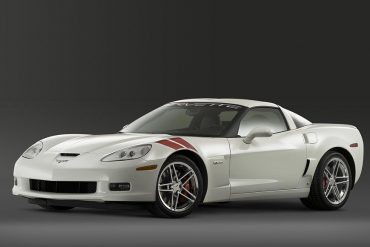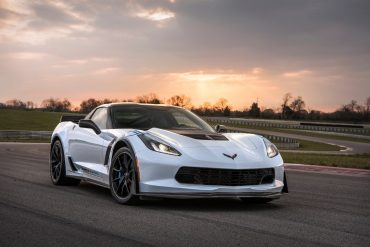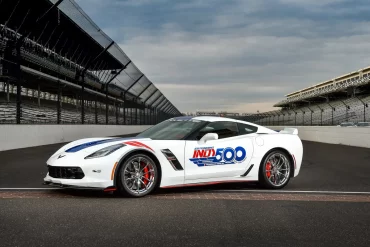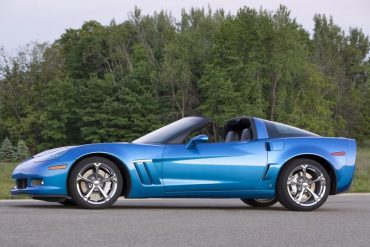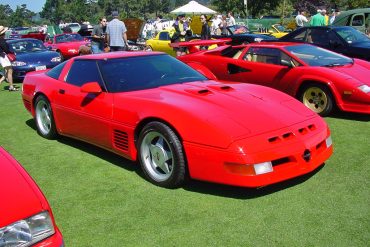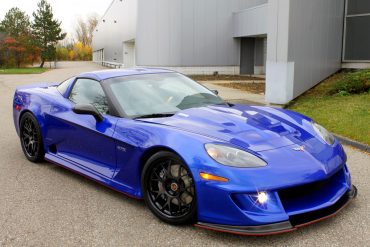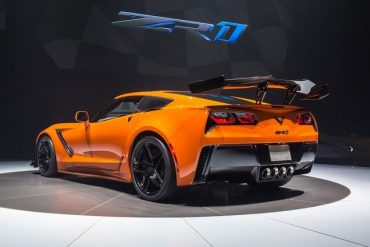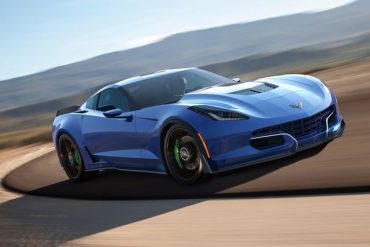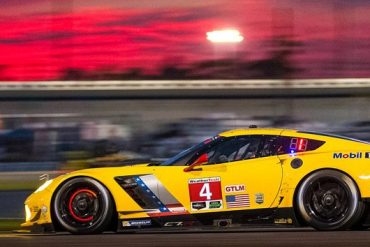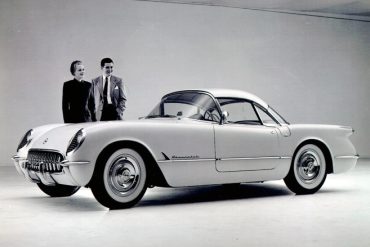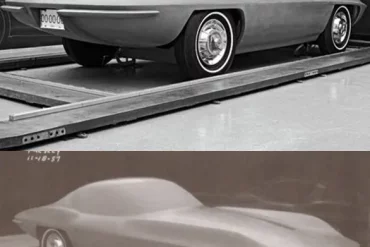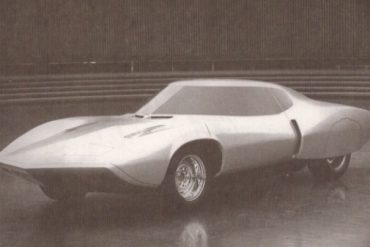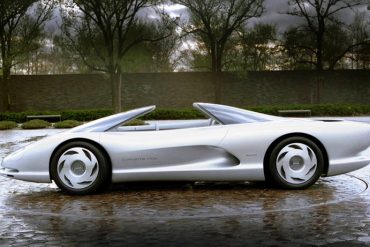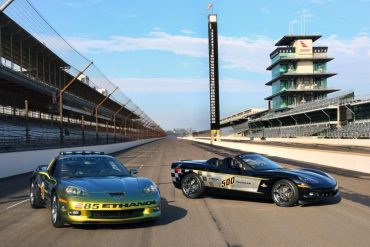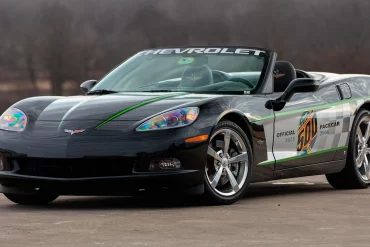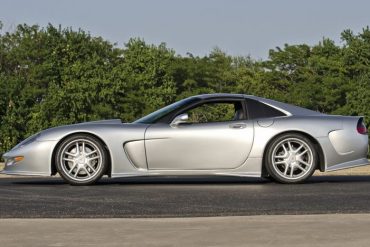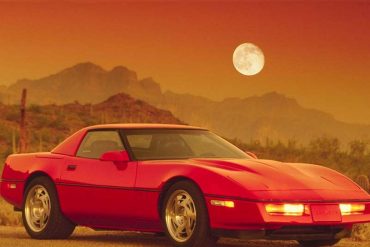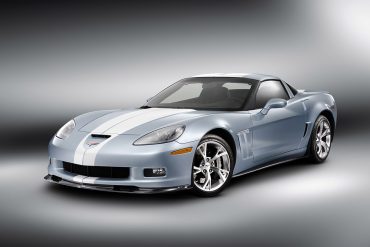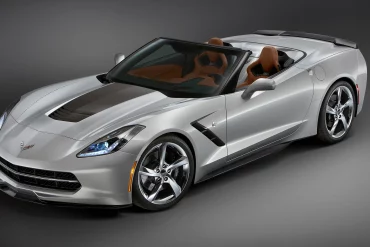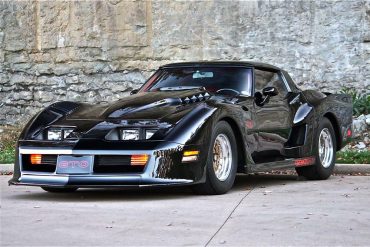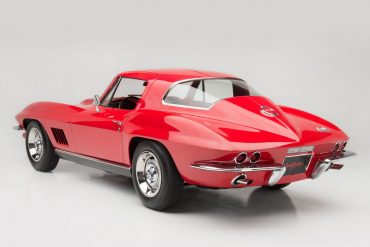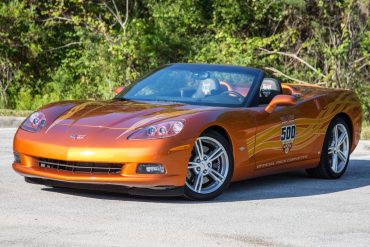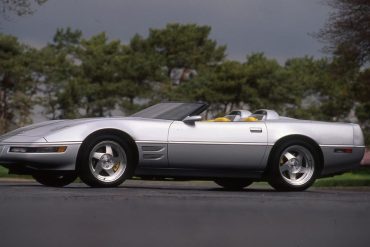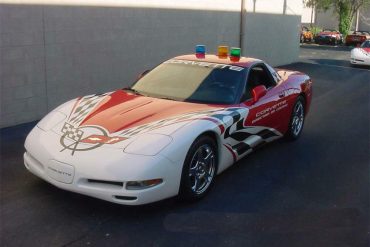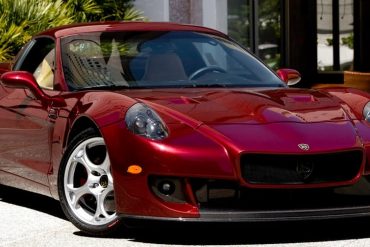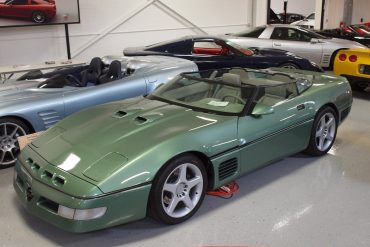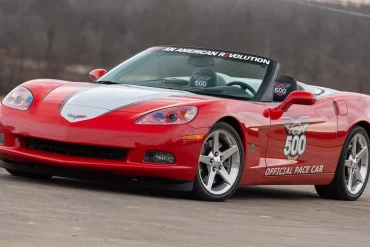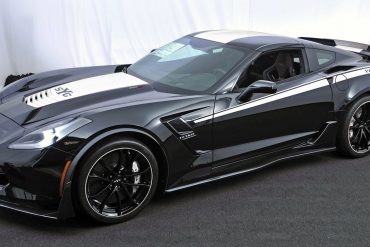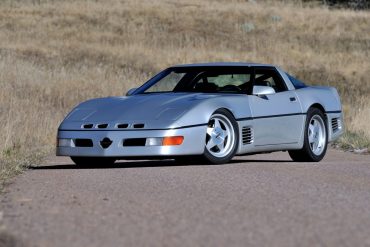The Ron Fellows ALMS GT1 Champion Edition Corvette was introduced as part of the 2007 Corvette line-up. To commemorate Mr. Fellows long and successful career with the Corvette Racing program, Chevrolet introduced the Ron Fellows Championship Edition Z06 Corvette as part of their 2007 model line-up. It was released as a commemorative model to celebrate one of GM's winning-est drivers, but did little to impress enthusiasts or collectors when first introduced.
As the 2018 model year approaches, the Chevrolet Corvette is about to reach another important milestone – its 65th anniversary! The Corvette, which for the past six-plus decades has been recognized as the nation’s most popular sports car, made its debut in Flint, Michigan on June 30, 1953. To commemorate the car’s 65th anniversary milestone, Chevrolet is introducing the Corvette Carbon 65 Edition as an available option on the 2018 Grand Sport 3LT and Z06 3LZ models.
The 2017 Chevrolet Corvette Grand Sport served as the official Pace Car for the 101st Indianapolis 500 presented by PennGrade Motor Oil and led drivers to the green flag on May 28. 2017 marked the 14th time a Corvette has served as the Indianapolis 500 Pace Car, starting in 1978, and the 28th time a Chevrolet has led the field, dating back to 1948, when a 1948 Fleetmaster Six convertible paced the race.
The 2010 Grand Sport Corvette was introduced to the world at the 12th annual C5/C6 Corvette Birthday Bash, which was (and is) held at the National Corvette Museum in Bowling Green, Kentucky. During its unveiling, it was announced that the new Grand Sport would be offered as either a coupe or a convertible, and it would feature an appealing combination of the LS3 power plant fused with the Z06 Corvette’s wide track chassis and styling features.
When Chevrolet changed gears to the LT1 engine, Callaway revealed their new SuperNatural line and the CR1 based on the ZR1’s LT5. Options for the CR1 included the radical Aerobody, German upholstery and special wheels, brakes and exhausts. The CR1 used a larger displacement to produce either 475 or 490 bhp.
Based on the Corvette Z06, this new GTR also represents a collaboration between Specter Werkes and Lingenfelter Performance Engineering, with a Lingenfelter twin-turbo system powering the car – and pumping its 7.0-liter LS7 engine to 800 horsepower. Featuring dramatic bodywork and carbon fiber details, the GTR blends racing-inspired design cues with uncompromising luxury and performance.
The Corvette ZR1 features an LT5 6.2L V-8 supercharged engine which dramatically advances the supercharging technologies first introduced in the 2009 sixth-generation Corvette ZR1 and continued with the 2015 seventh-generation Z06 Corvette. The engine, which is officially rated with an SAE-certified 755 horsepower (563 kW) and 715 lb-ft of torque (969Nm), establishes an entirely new benchmark in Chevrolet performance.
Genovation Cars unveiled an electric Corvette with more power under its hood than a Dodge Challenger Hellcat. They call their car the Genovation GXE, and it is an EV (electric vehicle) variant of the seventh-generation Corvette. The company decided that they would replace the factory LT1 engine found in all base-model C7 Corvettes with a pair of electric motors that, when working in conjunction with each other, provide over 800 horsepower and 700 pound-feet of torque.
The C7.R Corvette by Pratt & Miller is one of the winningest race cars in modern history. Explore what makes this Corvette a winner on race day, and discover the connection between the C7.R and the seventh-generation Chevy Corvette Z06. At the core of the C7.R Corvette is a direct carry-over from its predecessor - the same 5.5 liter engine that was developed during the C6.R's successful tenure in both the American Le Mans series and at The 24 Hours of Le Mans.
Besides a normal convertible model, the 1954 Chevrolet Corvette line-up also featured a hardtop, actually a Convertible Coupe. It was one of the Corvette based Motorama dream cars shown in 1954 and was a version fitted with a removable hardtop. The Advertising Brochure even called out the removable hardtop design.
Duntov laid out three design concepts that took decades to implement. The first was his proposal for the 1957 Q-Corvette. This design called for the following: an all-aluminum, fuel-injected small-block engine, four-wheel independent suspension, four-wheel disc brakes, and a transaxle. This design concept arrived in 1997 as the C5.
To clothe the 1965 mid engine Corvette chassis, the designers at Styling Staff proposed a much more radical shape than Zora Arkus Duntov, the main force behind a mid engine Corvette, had in mind. It would have provided rear vision solely through a periscope. The design had bold air intakes at the rear and a split windscreen that lifted up with the gullwing doors.
The first of these cars was the 1985 Corvette Indy Concept vehicle. It was developed as a “pushmobile,” meaning that it was a non-functioning, full-size clay mockup that was developed to test market interest in the concept. The car featured the same mid-engine configuration that Zora Arkus-Duntov had always envisioned for the Corvette program.
Known for their charismatic designs and superior performance, the pack-leading Pace Cars share a special place in Indianapolis 500 lore. History was made at the 2008 Indianapolis 500 when a pair of distinctive yet highly differentiated Corvette models served as the Official Pace Cars — one highlighting a commitment to fuel solutions and the other marking 30 years of Corvette's Pace Car heritage.
Total Production for the 2008 Indy Pace Car replicas sold to the public was 500. The first replica rolled off the production line approximately March 4th, and the last was June 6th. There were 61 Corvettes built in early March, however only 60 cars shipped to the Indianapolis Motor Speedway to be used as rack” and “festival committee" vehicles which were distributed to their lucky drivers on April 9th and in use thru May 31st.
Callaway has built a firm reputation for producing some of the most sophisticated and advanced Corvette-based automobiles. Introduced in 1998, Callaway’s C12 continued this proud legacy. Designed, developed and constructed by two top German engineering and development companies, Callaway and IVM, the C12 was intended as a bespoke, high-performance car that offered its occupants a civilized interior and relaxed ride. One of the most respected Corvette super-cars ever.
How do you beat a slew of Fox-Body 5.0 Mustangs that seemingly dominated the roads in the late '80s? You take a 454 cu.-in. big-block engine and stuff into a C4 Corvette and call it "Big Doggie". An experimental vehicle used to determine how to convert from a small block to a big block. Its 454 big block V8 along with its orange paint make this high horsepower engineering study a one-of-a-kind standout in Corvette history. The car had as much HP as the '90 ZR-1 did and it was named "ZR-2" or "Big Doggie". Old dog, new tricks joke?
The Carlisle Blue Grand Sport Concept is painted in a very cool Carlisle Blue exterior with exquisite Pearl White full-length racing stripes. This color combination is highlighted with Silver-painted Torque 2 wheels. The Corvette also benefited from carbon fiber front splitter and rockers, a full-width rear spoiler, and a Grand Sport style hood blanket. For the interior, Chevrolet has opted for Ebony/Titanium leather with blue stitching, a new Bose Premium Audio with nine speakers.
Chevyt presented a trio of Corvette Stingray concepts. Many of the items fitted to the cars are available through the Chevrolet Accessories and Chevrolet Performance catalogs. Designed with cruising in mind, the Stingray Atlantic convertible concept features stunning Blade Silver paint, while the Stingray Pacific concept is more race-inspired and the Stingray Gran Tourismo was created to commemorate the 15th anniversary of the Gran Tourismo video game.
The major differences between the 1980 and 1982 Daytona and the 1981 GTO are the hood, the tops of the rear fenders, and the rear spoiler/bumper cover. The Daytona had an elaborate, short vertical fin on top of the rear fender that turned several turns “in and back,” flowing to the wide, long, table-like rear spoiler. The GTO’s rear fenders pontoons are the same as.
The L88 was a special option package developed under the direction of Zora Arkus-Duntov, director of GM’s performance division. First introduced in 1967, the L88 Corvette featured a highly modified version of Chevy’s 427-cubic-inch V-8 engine. Although this engine received a factory horsepower rating of 435, actual engine output was somewhere between 540 and 580 horsepower, giving the “stock” L88 enough power to run a quarter-mile in the high-11-second range!
One special-edition Corvette was introduced in 2007 was based on the Corvette Pace Car that was used at the 91st running of the Indianapolis 500 driven by actor/racer Patrick Dempsey. The significance of this car was the fact that GM had not produced a pace car replica since the 1998 model year, even though the Corvette had paced the prestigious event a bunch of times since then.
Chevrolet Corvette ZR-1 Spyder prototype, 1991, by ASC. An experimental styling prototype ordered by Don Runkle, Chevrolet’s chief engineer, to see how far the ZR-1 might be pushed in convertible form. The windshield was chopped in half and the seats were mounted directly to the floorpan. The black example in the National Corvette Museum was originally painted Sebring Silver with a Neutrino Yellow interior.
Millions of spectators, broadcast viewers and listeners from around the world will be focused on the western region of France as one of Chevrolet’s fifth-generation family of Corvettes (referred to as C5) will pace an international field of sports cars as the Official Pace Car of the 67th running of the Le Mans 24 Hour race on June 12-13, 1999.
As early as the late 1990's, San Francisco based coach-builder SV Motor Company envisioned a car that took the raw performance of a Corvette and refined it with a touch of Italian flair. Their vision was to infuse many of the design elements found in the Alfa Romeo 8C Competizione (from which the SV 9 clearly drew its inspiration, as well as its name) with a 2009 Chevy Corvette.
In 1989 Callaway introduced a Speedster which was the culmination of their styling, engineering and trimming talents. Their first example was a bright green ZR1, which had a severely chopped windscreen, no side mirrors, eighteen inch wheels and a vibrant blue leather interior stitched purposefully from Germany. Nothing about Callaway’s Speedster was reserved, and this is especially true when investigating the specification. The car had 450 horsepower.
The 2005 Corvette Pace Car paced at the 89th Annual Indianapolis 500 on May 29, 2005. It was driven by Retired Army General and former Secretary of State Colin Powell. There were three Pace Cars produced. Eight Track/Festival convertibles painted Victory Red Corvette were used on race day. These Track/Festival Pace Cars did not have the center silver stripe, logo-embroidered headrest, and graphics that were on the actual pace car. There were two replica pace cars produced.
The Specialty Engineering Group (SVE) has partnered with Chevy to create the 2019 Yenko/SC Corvette Stage II. This new Corvette, which is the creation of Specialty Vehicles Engineering in cooperation with Chevrolet, delivers an incredible 1000 horsepower and 875 lb-ft of torque. Better yet, it's an option that you can order from your local Chevy dealership.
This Sledgehammer reached 254.76 mph at the Transportation Research Center (TRC) in Ohio and became the world’s fastest street-legal car for some time. It was built up by Reeves Callaway in Connecticut as an example of what was possible with the new ZR1 and and turbocharging its LT5 engine. The result was a 898 bhp coupe that still retained luxuries such as air conditioning and a radio. It got this power by using a NASCAR-spec block with Mahle pistons and a massive turbo.
The all-new, seventh-generation 2014 Corvette Stingray served as the Indianapolis 500 Pace Car, leading the field to green at the start of the 97th running of “The Greatest Spectacle in Racing,” on Sunday, May 26 2013. It marked a record 12th time the Corvette served as the Pace Car, starting in 1978. Jim Harbaugh, head coach of the NFL’s San Francisco 49ers, drove the all-new 2014 Chevrolet Corvette Stingray Pace Car


